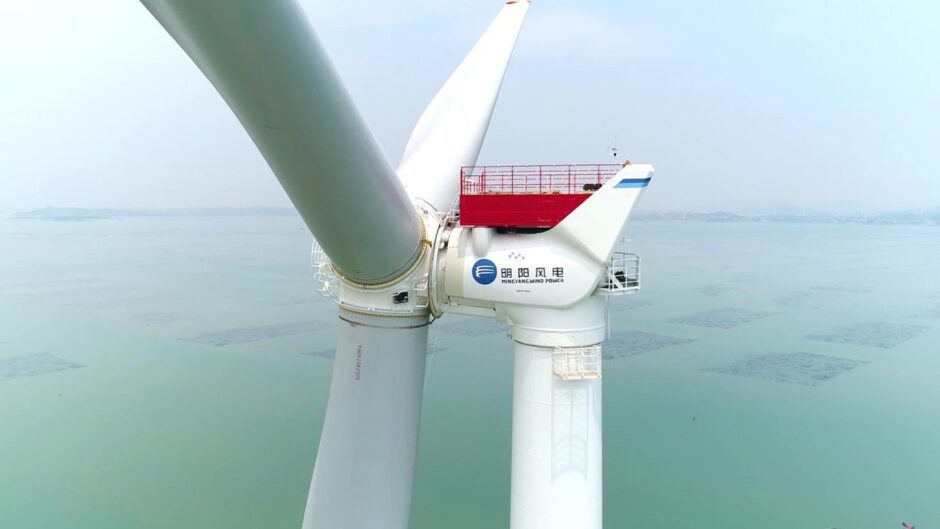
The UK’s offshore wind industry has been divided over a proposed Chinese turbine facility, but slow progress could put the potential investment at risk.
Isla Robb, who served as managing director of Opergy Scotland before her recent move over to ETZ Ltd, warned that, rather than building facilities in the UK or Europe, potential investors could “set up in China and just ship everything over”.
A lack of domestic manufacturing capacity to take advantage of the UK’s offshore wind boom has long been a sore point for the industry. Despite the country’s strong project pipeline, only a few parts are made in the UK – such as blades at Siemens Gamesa’s facility in Hull.
Foreign players building factories in the UK is seen as offering a course correction. Sumitomo has a cable facility in development near the Port of Nigg, while Vestas has plans to build a blade factory at the Port of Leith.
But the most controversial development has been plans by Mingyang Smart Energy (LON:MYSE), China’s largest privately owned turbine manufacturer, to come to the UK.
The company previously partnered with Norfolk-headquartered Opergy Group, through its Opergy Scotland division, to explore entering the UK’s offshore wind market.
“Opergy Scotland had some great conversations with Mingyang, as well as multiple other potential Chinese suppliers,” Robb told Energy Voice.
The group created a report to identify potential ports and facilities in Scotland that could house manufacturing facilities for turbines and foundations.
“The initial report with them was to look at, is this a market worth entering and why. Then the conversation started exploring, if they were to locate in the UK, where would they locate and why.”
Chinese entry
While Mingyang’s plans for a potential UK entrance have still to be fully defined, a 2021 memorandum of understanding with the then Conservative government set out plans to invest in blade manufacturing, a service centre and possibly a turbine assembly facility in the UK.
An unspecified wind turbine OEM facility from the company has made progress through the Strategic Investment Model (SIM), reaching the second stage of the supply chain initiative overseen by the Scottish Offshore Wind Energy Council (SOWEC).
The exact details of the project are still to be revealed, especially where it will be based and what exactly it will produce.
“Mingyang were keen to start small, as in look at projects that had fewer turbines, to begin with,” Robb explained.
“They were also looking at which part of the turbine they would manufacture here. At the early stages, they were looking at all parts of the turbine, which they could do in multiple locations across the UK and manufacture all parts of the turbines.”
However, given the scale of modern offshore wind turbines, any facility would also have to be massive. Any factory would need “a massive blank canvas to locate it, which limits where it could go in the UK,” Robb noted.
“When Opergy were speaking to them, Mingyang was open to getting everything in one location,” Robb said. “But they could spread the wealth around the UK, if it was going to be economically worthwhile for them.
“We’ve got to bear in mind there’s a huge number of projects in Scotland, but there’s a lot off the East coast of England and also coming to the Celtic Sea as well, so we can’t assume that everything is going to happen in Scotland. There are other opportunities as well.”
Another factor that will determine where the facility is based is which developers are interested in using Mingyang’s turbines.
“They’ve probably been busy speaking to all the developers – the extent to how far those conversations have gone would have to be between the developers and Mingyang,” Robb said.
Alternative supplier
UK offshore wind effectively relies on a duopoly of turbine suppliers, with Vestas and Siemens Gamesa dominating (with the US’s GE Vernova making inroads after supplying several projects, including Dogger Bank).
“Developers want an alternative,” Robb noted.
“Everywhere in the world basically uses the same developers, turbine suppliers and tier ones – apart from China. China is a significant market and if we want to find an alternative supplier, China is our only source.”
Not only does the small pool of turbine suppliers represent a supply chain risk to developers, it also puts the UK’s, and the world’s, renewable energy ambitions in jeopardy.
A report from the Department of Energy Security and Net Zero (DESNZ) warned that demand could outstrip supply across a variety of components vital for offshore wind projects in the near future, as manufacturers and fabricators struggle to scale up production to meet a growing number of projects.
“With the scale of the offshore wind opportunity coming down the pipeline, in the next five to ten years, the existing turbine suppliers will not be able to meet the demand unless they set up a new factory themselves,” Robb said.
“Even if they did, the demand worldwide cannot be met by the current suppliers.
“There is so much demand that developers will be buying from an alternative supplier, so we want that alternative supplier to be here and not shipping things here.”
Due diligence
The potential presence of a Chinese company in the UK’s renewable supply chain has proven controversial. Analysts and government figures have claimed that giving a China-based company risks giving the Chinese Communist Party access to the UK’s power infrastructure.
In a worse case scenario, deteriorating relations could see the Chinese government using this access to sabotage the UK’s power supplies.
While Mingyang has an office in Germany, creating a manufacturing facility would be its first in Europe, allowing it to supply not just the UK’s projects, but the greater North Sea as well.
“Any inward investor is going to have scrutiny from the government,” Robb said. “If you’re a Chinese inward investor, you get to a different level of scrutiny as well reputationally.
“When Opergy was speaking to Mingyang, they said to them if you’re coming to the UK, it has to benefit the UK as well, not just the jobs in your own factory, but you need to have your own supply chain. You can’t just come and everything comes from China.
“In an ideal world, they would bring the steel from their factory, but the likes of the control mechanisms comes from UK companies.
“This security issue, we can get around that by making sure that we’re using UK companies. That way the data doesn’t go back to China, it’s used by UK supply chain companies that are providing what gathers that data.”
“We need another player in the market, but we have to get comfortable with doing strict due diligence on whoever comes into the country.”
Closing window
Delegates to Offshore Wind Conference 2025 recently spoke out in favour of both Mingyang’s presence in the UK and Chinese investment in the country’s offshore wind sector.
GB Energy chairman Juergen Maier said at the event’s opening session that ignoring China’s potential contribution to the UK’s renewable sector “would be crazy”.
He warned against pursuing “protectionist practices” in favour of focusing on a more modern industrial strategy.
Though he did add that an exception should be made where the government determines there is a national security issue.
And the UK managing director of floating wind developer Blue Float Energy Nadara Partnership Susie Lind warned that the government needed to provide clear signals soon about Chinese investment.
“Because there’s a chance that time is of the essence, we need certainty,” she said.
The risk is, Robb warned, that Mingyang has more options to build a factory than the UK and offshore wind developers have suppliers.
“The UK is a significant market, but Mingyang has an office in Germany,” Robb said. “If we are making it hard for them, they’ll go elsewhere.
“If we don’t move quickly, then somebody else will take this opportunity. And Mingyang are busy enough in their own country. If people still need them and developers still want them, they could just build another factory in China and everything will get shipped over from China.
“And in that alternative, nobody in Europe gets it at all. Mingyang just meet the demand from China.”
While performing due diligence on Mingyang is essential, Robb added that delays could drive the company away.
“What I’ve been painfully aware of with working with other Chinese companies is things happen really quickly in China. If they want a new factory, they’ll get the new factory next week. Not like in the UK where it takes a long time.”
This, in turn, could discourage other foreign investors, from China and elsewhere, from investing in the UK and providing the funds needed to build out its manufacturing capacity.
“We’re getting this opportunity to manufacture something in the UK and now we’re being a bit too choosy,” Robb said.
“While Mingyang seems to be the talking point at the moment, there are plenty of other Chinese suppliers that we could benefit from. There will be other suppliers that we could have in offshore wind, in in hydrogen, electrolysers, we don’t want to close the doors to opportunity for our energy sector and jobs for the wrong reasons.”
Recommended for you


 © Supplied by ETZ Ltd'
© Supplied by ETZ Ltd' © Supplied by Mingyang
© Supplied by Mingyang © Supplied by DESNZ
© Supplied by DESNZ